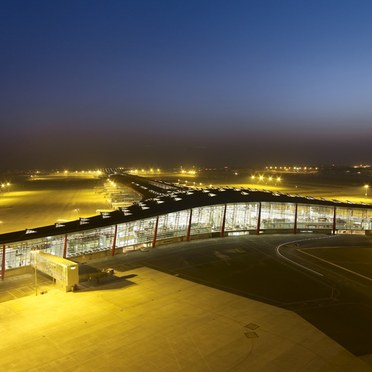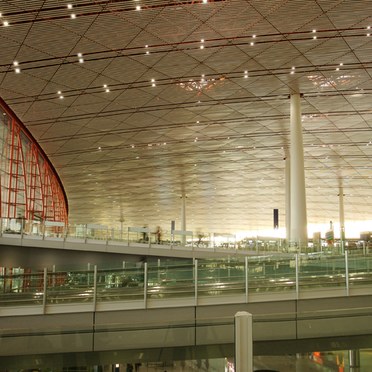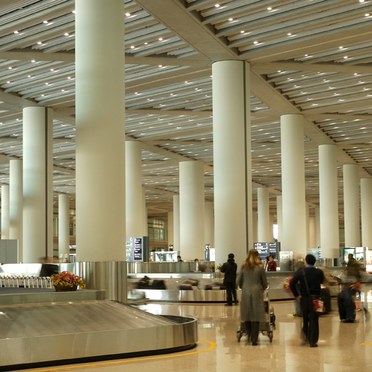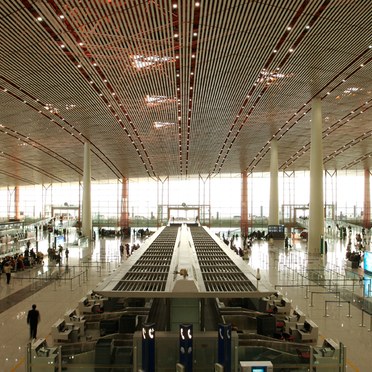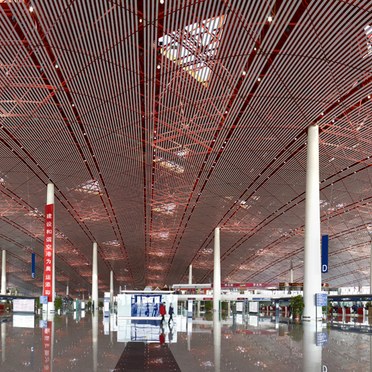Beijing Airport, China
- Lamp efficacy
Lamp efficacy
Ensuring the lamp efficiently converts electricity into light (lm/W).
- Ballast classification
Ballast classification
Controlling the electricity supply to the lamp (Energy Efficiency Index).
- Luminaire distribution
Luminaire distribution
Controlling light emission using optics which bend and shape the light to the correct location.
- System efficacy
System efficacy
Combining optical and thermal control within the luminaire (luminaire lm/W).
- Presence/absence detection
Presence/absence detection
Presence: Lights automatically turn on/off with movement. Absence: Lights automatically turn off and must be manually switched on.
- Daylight detection
Daylight detection
Artificial lighting which responds to the natural light conditions.
- Constant illuminance
Constant illuminance
A function designed to produce correct light levels for the duration of the maintenance period.
- Task-scene setting
Task-scene setting
Allowing the user to set scenes and adapt the lighting to different tasks.
- Timed off
Timed off
Automatic cut-off can be installed to turn all lights off during unoccupied hours.
- Task lighting
Task lighting
Lighting task areas with the correct amount of light.
- Zoning of lighting
Zoning of lighting
Lighting is zoned according to area use.
- Maintenance schedule
Maintenance schedule
Maintenance must be performed in response to product age, performance and environment.
- Waste light
Waste light
Eliminating waste light which does not hit the intended target.
- Reflectance
Reflectance
Taking advantage of light which is reflected from the surface within the space.
- Visible smart metering
Visible smart metering
Results of actions can be quickly seen as increased or decreased energy use to encourage responsible energy consumption.
New terminal lit with 70,000 luminaires
All airports rely on light. It is used to accentuate the architectural features of terminal buildings, provide relaxing, sustainable environments for passengers and staff and enables efficient management of baggage and cargo handling activities.
Thorn has a long history of involvement in many of the world's major airport projects, but nowhere is the company's ability to provide a total lighting solution more clearly demonstrated than at Beijing's latest 2008 Olympics project – the monumental International Airport Terminal 3 building. This is the new gateway to China and, with a concourse nearly two miles long and a half-mile wide, is the world's largest covered structure.
Performance
Around 70,000 luminaires have been supplied for the terminal and its associated Ground Traffic Centre. For such a vast space the lighting plan had to serve a dual purpose: not only provide sufficient illumination for the task, but be free of glare, thereby lessening eye fatigue and strain; and increasing staff performance and motivation.
Efficiency
The lighting options supplied combine low running costs with ease of maintenance and practical performance. Many of the luminaires are fitted with a unique rotating mounting bracket for easy access from the lofty maintenance catwalks.
Comfort
The terminal's designer, Lord Foster, placed a premium on space and light, producing an airy glass-and steel structure employing distinct Chinese colours and characteristics. Its rising aerodynamic roof reflects the feeling of aviation as well as being representative of a dragon, complete with triangular skylights that resemble scales. The lighting creates an ambience that combines grandeur with intimacy. It is also used to enhance the colours - at the entrance passengers encounter a blaze of crimson, reminiscent of good luck and happiness, while inside gold is used for its association with the earth and calmness.
The lighting was developed in conjunction with a joint venture design and engineering team, comprising Dutch airport planners NACO, engineers Arup and the Beijing Institute of Architectural Design and Research.

